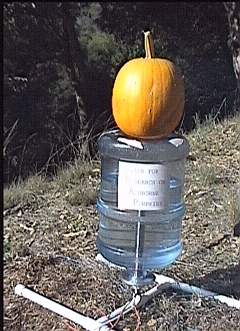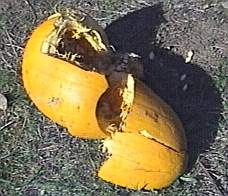This is my second effort to get a pumpkin in the air using water-rocket technology. My first attempt is here.
Big rocket
I recognized two essentials: (1) I needed a big rocket and (2) The pumpkin should sit intact on top of this rocket. This picture shows just such a configuration. The pieces of tape were placed earlier on the top of the bottle to guide me in getting the pumpkin mass centered on the bottle.

I used my second-generation hydrogen-power method to pressurize the rocket. In particular, I built the launch platform shown above out of aluminum, steel, and PVC so it could hold up to 200N (45 pounds) static weight plus significant additional forces during liftoff.
Bubble, bubble
Here is a picture of the fuel mix (2/3 hydrogen and 1/3 oxygen) bubbling into the rocket vessel, a 5gal/19L water-cooler bottle. A bit of the bottle neck has been removed to make a smoothly tapering nozzle with 5cm exit diameter. Notice how the water drips out as the gas goes in--that way I always know how much gas I have added. [If your browser is IE then put the cursor over the image for animation.]

Just prior to launch the bottle contained about 9L of water. The remaining space was about 1/3 fuel mix and the rest air. Estimated pressure after ignition is 7.4 bar (108 psig).
Oh yeah!
Below is a javascript slideshow of launch pictures, taken 1/60 second apart. Notice what happens to the pumpkin immediately after ignition due to the bottle bulging. Also interesting are the radially symmetric plumes coming off the water column later during thrust. These plumes are observed also in my high-speed videos of smaller rockets.

Here is a movie of the entire flight. The AVI file (size 2.3 MB) is encoded in DivX format and runs natively at 60 frames per second.
Both the pumpkin and bottle reached an estimated apogee of 18m (60ft). That they both reached the same altitude demonstrates that aerodynamic drag did not play much of a role in this flight.

The pumpkin carcass.
Foolishly,
I decided to do a high-pressure test of the launch vehicle. Just prior to ignition the bottle contains about 8L water, with the remainder being 3/4 fuel mix and 1/4 air. Estimated pressure after ignition is 11.7 bar (170 psig). Here is a series of “launch” photos, 1/60 second apart.

I think I can say reliably that 11.7 bar is above the engineering specs for water-cooler bottles.
